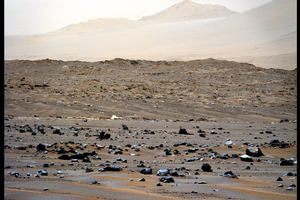This ocean existed 3.5 billion years ago.

Scientists from the University of Pennsylvania found signs that that 3.5 billion years ago there was a large ocean on Mars that covered hundreds of thousands of square kilometers. Its existence was indicated by the topography of the coastline revealed in numerous pictures of the Red Planet, reports Science alert.
Researchers managed to map more than 6,500 kilometers of ridges. As a result, scientists found that these ridges are most likely eroded river deltas or underwater channel belts that appeared on the sea floor.
Also read: Ancient microbes caused climate change on Mars, who could not survive
“On Earth, we map the history of waterways by observing the sediments that have formed over time. We call this stratigraphy, the idea that water carries sediments, and you can measure changes in the Earth by understanding how sediments accumulate. That's what we did here – but it's Mars,” said Benjamin Cardens, one of the authors of the study.
During the study, scientists used data collected by the Mars Reconnaissance Orbiter in 2007. Scientists analyzed the thickness, angles and location of the ridges. This helped them trace the history of the region they were studying: the Aeolis Dorsa topographic depression.
According to Cardens, it is likely that the region underwent large-scale changes in the past. This is evidenced by the signs of a significant rise in sea level and the rapid movement of rocks by rivers and streams. To date, Aeolis Dorsa contains the most concentrated collection of river ridges on Mars.
All these discoveries are important from the point of view of searching for traces of past life on the planet. If an ocean of this size once existed on Mars, it could potentially be an environment suitable for the development of life.
“It also tells us about the ancient climate and its evolution. Based on these findings, we know that there must have been a period when it was warm enough and the atmosphere was dense enough to support this much liquid water at the same time,” Cardens added.
And scientists are not stopping their research. only on Aeolis Dorsa. In another study, in which Cardens also participated, scientists applied an acoustic imaging technique used to map the ancient seafloor in the Gulf of Mexico to a model of how water might have eroded the surface of Mars.
Throughout Red the planet is dotted with areas that may be ancient river ridges. The simulation, which was carried out by scientists, showed the formation of a landscape surprisingly similar to the Martian one. This suggests that there was once a large body of water here.
Related video
“If there were tides on ancient Mars, they would have been here, gently bringing and carrying water. This is exactly the place where ancient Martian life could have developed,” Cardens believes.




